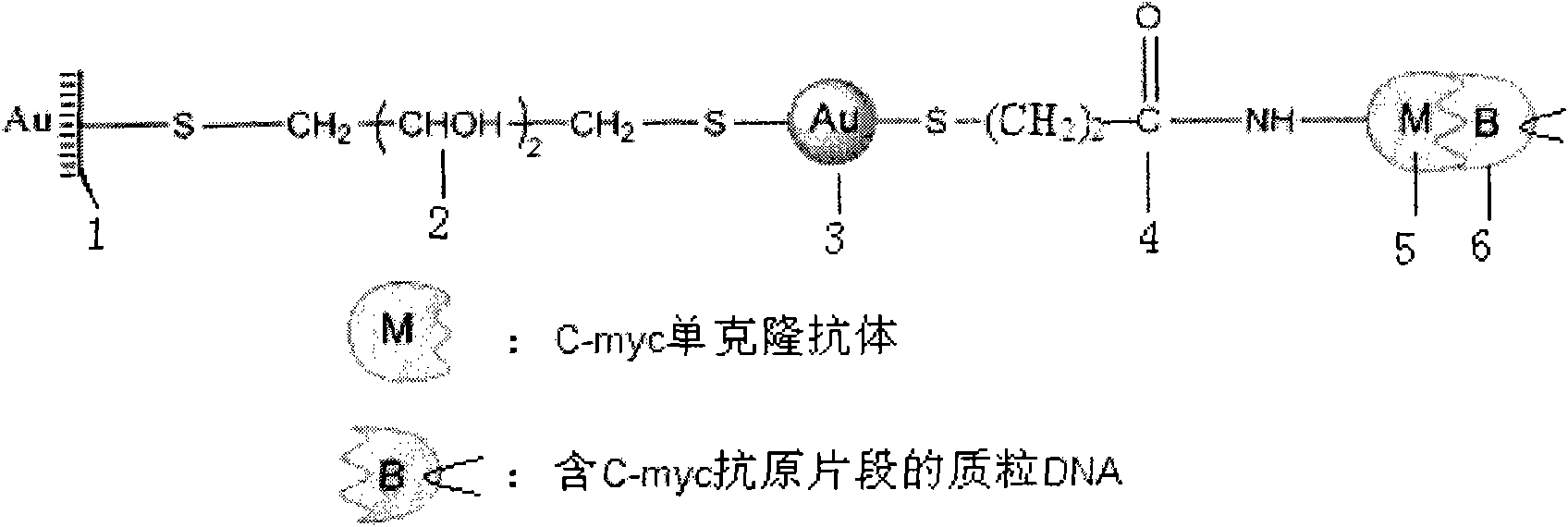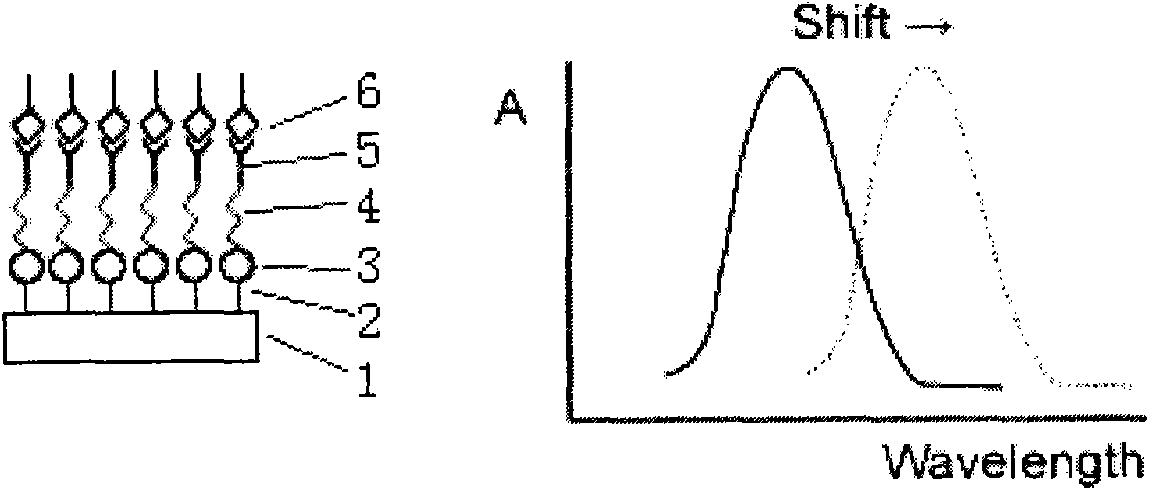LSPR (Localized Surface Plasmon Resonance) sensing chip for detecting plasmid DNA (deoxyribonucleic acid) containing oncogene C-myc antigen fragment
A sensor chip and oncogene technology, applied in the direction of measuring devices, instruments, scientific instruments, etc., can solve the problems of anti-interference, insufficient selectivity, application limitations, cumbersome operation, etc., and achieve good selectivity and reproducibility, High sensitivity, rapid quantitative effect
- Summary
- Abstract
- Description
- Claims
- Application Information
AI Technical Summary
Problems solved by technology
Method used
Image
Examples
Embodiment 1
[0019] Assembly preparation of LSPR sensor chip:
[0020] 1) A layer of 100nm gold film was coated on the surface of polystyrene plastic and silicon oxide glass substrate by magnetron sputtering coating method, and the vacuum degree of the coating film was controlled to be 1.0×10 -4 Pa, the coating speed is Make the surface of the gold film smooth and smooth to form a gold plate electrode;
[0021] 2) Add Piranha solution (Note: Piranha solution is a solution of concentrated sulfuric acid: hydrogen peroxide = 7:3) dropwise on the surface of the gold plate electrode to soak for 15s, take it out and rinse it with twice distilled water repeatedly for 3 times;
[0022] 3) Soak the above electrodes in absolute ethanol and double distilled water for 60s;
[0023] 4) Immerse the above electrode in 50mmol / L DTT solution, place it for 10h to form a DTT monolayer, rinse it with absolute ethanol for 3 times to remove the free DTT on the surface, and then rinse it with twice distilled ...
Embodiment 2
[0029] Determination of standard curve of plasmid DNA containing C-myc antigen fragment:
[0030] 1) The reagents used (double distilled water, PBS buffer solution) were sterilized and stored at 4°C for later use;
[0031] 2) Take 1 μL of plasmid DNA in a 1.5mL small test tube, use PBS as a buffer solution, dilute 1-100000 times respectively, and prepare a series of solutions of 0-1.5 μg / mL for later use;
[0032] 3) The LSPR sensor chip modified with the above-mentioned C-myc monoclonal antibody was used to test the plasmid DNA samples of various concentrations respectively, and the immunoreaction of the C-myc monoclonal antibody with the plasmid DNA containing the C-myc antigen fragment was combined to cause a reaction on the chip. The absorption peak of local surface plasmon resonance spectrum of gold nanoparticles is red-shifted, and the peak displacement has a linear response relationship with the content of plasmid DNA; with the concentration C (μg / mL) of plasmid DNA as ...
Embodiment 3
[0035] Determination of the concentration of plasmid DNA containing the C-myc antigen fragment in Escherichia coli:
[0036] In this embodiment, the alkaline lysis method is used to extract the plasmid DNA containing the C-myc antigen fragment in Escherichia coli, and the specific operation method is as follows:
[0037] 1. Take 1% Escherichia coli cells containing the plasmid in 2ml LB medium, shake and culture overnight at 37°C, take 1.5ml cells into an Ep tube, centrifuge at 4000rpm for 3min, and discard the supernatant.
[0038] 2. Add 0.1ml solution I (1% glucose, 50mM / L EDTA pH8.0, 25mM / L Tris-HCl pH8.0) and mix well. Add 0.2ml solution II (0.2mM / L NaOH, 1% SDS), gently invert to mix, and place in ice bath for 5min. Add 0.15ml precooling solution III (5mol / L KAc, pH4.8), gently invert and mix well, and place in ice bath for 5min.
[0039] 3. Centrifuge at 1000rpm for 20min, take the supernatant into another new Ep tube, add an equal volume of isoamyl alcohol, mix well,...
PUM
| Property | Measurement | Unit |
|---|---|---|
| Thickness | aaaaa | aaaaa |
| Particle size | aaaaa | aaaaa |
| Particle size | aaaaa | aaaaa |
Abstract
Description
Claims
Application Information
 Login to View More
Login to View More - R&D
- Intellectual Property
- Life Sciences
- Materials
- Tech Scout
- Unparalleled Data Quality
- Higher Quality Content
- 60% Fewer Hallucinations
Browse by: Latest US Patents, China's latest patents, Technical Efficacy Thesaurus, Application Domain, Technology Topic, Popular Technical Reports.
© 2025 PatSnap. All rights reserved.Legal|Privacy policy|Modern Slavery Act Transparency Statement|Sitemap|About US| Contact US: help@patsnap.com



